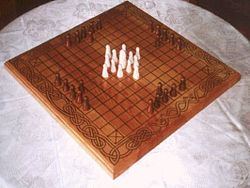Our website is made possible by displaying online advertisements to our visitors.
Please consider supporting us by disabling your ad blocker.
Tafl games
 A reconstructed hnefatafl gameboard | |
| Years active | 4th–12th centuries |
|---|---|
| Genres | |
| Players | 2 |
| Setup time | < 1 minute |
| Playing time | Typically 5–20 minutes |
| Chance | None |
| Skills | Strategy, tactics |
| Synonyms | Hnefatafl |
Tafl games (pronounced [tavl]), also known as hnefatafl games, are a family of ancient Northern European strategy board games played on a checkered or latticed gameboard with two armies of uneven numbers. Names of different variants of tafl include hnefatafl, tablut, tawlbwrdd, brandubh, Ard Rí, and alea evangelii. Games in the tafl family were played in Norway, Sweden, Denmark, Iceland, Britain, Ireland, and Sápmi.[1] Tafl gaming was eventually supplanted by chess in the 12th century,[2] but the tafl variant of the Sámi people, tablut, was in play until at least the 18th century. The rules for tablut were written down by the Swedish naturalist Linnaeus in 1732, and these were translated from Latin to English in 1811. All modern tafl games are based on the 1811 translation, which had many errors. New rules were added to amend the issues resulting from these errors, leading to the creation of a modern family of tafl games. In addition, tablut is now also played in accordance with its original rules, which have been retranslated.[3]
- ^ Murray 1951, p. 56, Helmfrid 2005, p. 2 Duggan 2015
- ^ Murray 1951, pp. 56–57.
- ^ Walker, Damian. "Tablut". Hnefatafl – the Game of the Vikings.
Previous Page Next Page


